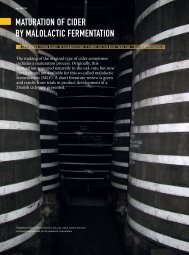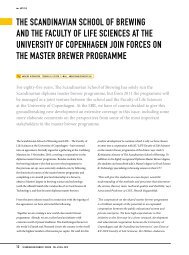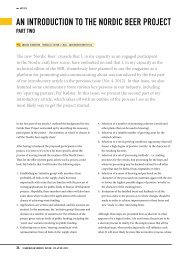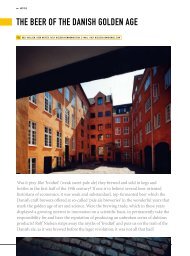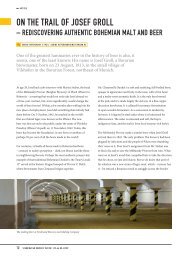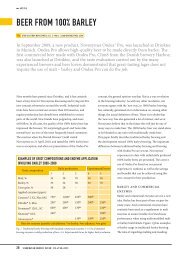the Supply chain ManageMent proceSS - Scandbrewrev.dk
the Supply chain ManageMent proceSS - Scandbrewrev.dk
the Supply chain ManageMent proceSS - Scandbrewrev.dk
You also want an ePaper? Increase the reach of your titles
YUMPU automatically turns print PDFs into web optimized ePapers that Google loves.
The <strong>Supply</strong> Chain Management Process<br />
was that our product met <strong>the</strong>ir specification. Although on-time<br />
delivery was important, it was no use if <strong>the</strong> product arrived<br />
on time but was below <strong>the</strong> required standard. In our example,<br />
<strong>the</strong> customer gave a performance ‘score’ of 80% for meeting<br />
specification (quality) and 60% for time (late deliveries). Price<br />
was OK. Having established <strong>the</strong> customers’ perception of <strong>the</strong><br />
service provided, <strong>the</strong> next step was to determine why <strong>the</strong> rating<br />
was below 100% for Specification and on Time delivery. In<br />
<strong>the</strong> consequential analysis of <strong>the</strong> three key resource inputs, it<br />
was found that machines and equipment were first class (latest<br />
technology, well maintained with no unplanned down time), <strong>the</strong><br />
people had <strong>the</strong> requisite skills, were reliable, <strong>the</strong> error rate is low,<br />
but <strong>the</strong>re was some idle time (productivity could be better). It<br />
was thought that improvements to people efficiency with more<br />
training could be achieved. However, <strong>the</strong> major constraint was<br />
that our suppliers were not sufficiently reliable (late deliveries<br />
and materials not always up to our quality standards). Action<br />
was taken to improve communication with key suppliers as to<br />
what was required. Gap analysis does not provide solutions to<br />
<strong>the</strong> conflicts, but identifies broad areas for attention.<br />
It is also important to note that <strong>the</strong> relative priorities of VOB<br />
and VOC can vary within <strong>the</strong> same business depending on<br />
<strong>the</strong> product and customer. To find solutions, <strong>the</strong> <strong>Supply</strong> Chain<br />
Manager will seek o<strong>the</strong>r tools, techniques and processes of<br />
<strong>Supply</strong> Chain Management such as Enterprise Resource<br />
Planning (ERP), which we will explain in later papers.<br />
The old approach to manufacturing was to buy from preferred<br />
suppliers and to negotiate terms and conditions to maximise<br />
your individual position and profit. Heavy reliance was placed<br />
on legal contracts and, if a large consumer, using purchasing<br />
power to gain favourable terms. Internally, <strong>Supply</strong> Chain<br />
Management would be considered to be <strong>the</strong> combining of<br />
functions of <strong>the</strong> business to plan, source, make and deliver<br />
products and services that meet customer needs as efficiently<br />
and as profitably as possible. In dealing with suppliers and<br />
immediate customers, <strong>the</strong> aim would be to get as good a deal<br />
as possible in buying from suppliers, and to get <strong>the</strong> best price<br />
from <strong>the</strong> customers and to maximise our profit. The belief being<br />
that for every winner <strong>the</strong>re has to be a loser, and <strong>the</strong> best way to<br />
maximise your position is to be <strong>the</strong> winner.<br />
Our approach for <strong>Supply</strong> Chain Management is to maximise<br />
<strong>the</strong> value for <strong>the</strong> complete <strong>chain</strong>. This is achieved through<br />
unreserved sharing of information and benefits. To do this, some<br />
long held beliefs, such as <strong>the</strong> concept of not sharing information<br />
for commercially sensitive reasons, have to be overcome. In<br />
reality, very little can truly be kept secret in today’s global<br />
environment. Any new advance in manufacture and technology<br />
will soon become common knowledge, copied and invariably be<br />
improved upon by <strong>the</strong> competition. Sharing of information and<br />
trust, not reliance on contacts, is <strong>the</strong> corner stone of true <strong>Supply</strong><br />
Chain Management.<br />
The individual components of <strong>Supply</strong> Chain Management are<br />
not new; we all have been managing parts of <strong>the</strong> supply <strong>chain</strong><br />
for years (e.g. buying, planning, scheduling, stock control,<br />
warehousing, logistics, distribution, etc.) without fully realising<br />
<strong>the</strong> significance of <strong>the</strong> whole <strong>chain</strong> concept. Likewise, <strong>the</strong> cost<br />
of <strong>the</strong> various elements of supply and distribution has been long<br />
recognised, over 90 years ago, for example, Ralph Barsodi (1929)<br />
wrote, ‘between 1870 and 1920 <strong>the</strong> cost of distributing necessities<br />
and luxuries has nearly trebled, while production costs have gone<br />
down by one fifth – what we are saving in production we are<br />
losing in distribution’.<br />
As indicated in illustration 2 on page 14, <strong>the</strong> traditional<br />
supply <strong>chain</strong> was concerned with a linear flow of information<br />
and products/services from customers to suppliers through<br />
various stages of processes while <strong>the</strong> information flow was <strong>the</strong><br />
domain of <strong>the</strong> commercial division and <strong>the</strong> conversion process<br />
of materials flow was a manufacturing or technical division<br />
responsibility. During <strong>the</strong> 1990s, <strong>the</strong> concept of total <strong>Supply</strong><br />
Chain Management shifted <strong>the</strong> responsibility for all elements of<br />
supply <strong>chain</strong> from cross functional control by one function ei<strong>the</strong>r<br />
Operations Management or to <strong>Supply</strong> Chain Management.<br />
The ‘old’ approach was that one department or function would<br />
be responsible for purchasing goods and services, ano<strong>the</strong>r for<br />
planning. Scheduling of activities was often a separate function,<br />
as was warehousing and distribution, and operations were just<br />
one step in <strong>the</strong> whole process of providing services. With <strong>the</strong><br />
value stream approach, functional boundaries are ignored and<br />
in many organisations it is now accepted that <strong>the</strong> operations<br />
16 SCANDINAVIAN BREWERS’ REVIEW . VOL.67 NO.3 2010



